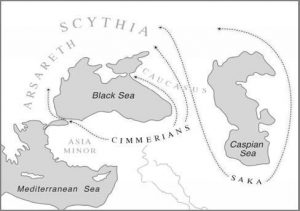Pastor Eli James Addresses Barnes Review Perspective on Biblical History
Here is the link to EFR’s AC Hitchock’s interview with John Tiffany, editor of the Barnes Review.
January/February 2017 Issue: John Tiffany – Was Judaism An Invention Of The Persian Empire?
I read Mr. Tiffany’s article and responded to Mr. Tiffiany, with his questions and comments included.
Mr. Tiffany, thanks for responding. I will in turn respond to your comments and questions; but first let me send you one of my articles on the subject of the origins of the Jewish people:
From Cain to Khazaria | Anglo-Saxon Israel
The above article contains a detailed analysis of the Canaanite/Edomite origin of the Jewish people, with copious quotations from Jewish articles admitting same.
From a letter written to the editorial board of the Barnes Review:
Now to your comments. I will answer in braces{}:
Mr. Tiffany is 100% correct in saying that Adam and Eve could not have been Jews, nor could any ancestor of Judah have been called after his name, as Judah was the offspring of Jacob. This includes Abraham, Isaac and Jacob. Grandsons are named after their grandfathers, not vice versa. The claim that any of Judah’s predecessors were “Jews” is obviously ridiculous and anachronistic. It is important to understand, however, that Jewish perversions do not impugn the Bible. Since the Jews had nothing to do with the writing of the Bible, anything they say about it must be taken with a shaker of salt. The idea that the Jews are Israel is the first lie.
[I don’t believe my article stated that the Jews are ancient Israel. If I somehow gave that impression it was not intended.–JT]
{Most secular analyses of Scripture start with that assumption. If you don’t, good for you; because that is indeed the first lie. –EJ}
Unlike Jewish fables, the Bible has been proven to be a historically accurate book, over and over, by archeological research. Joseph’s granaries have been found in Egypt.
An inscription by the Egyptian priest, Ameni, gives the details of a famine lasting many years, along with the years of preparation, which are dated back to the time of Pharaoh Sesostris I, circa 1600 BC. The path that the Israelites took out of Egypt has been located by heat-sensitive aerial photography, as the trail of 2 million souls left a distinct impression on the ground there, having left a kind of concrete made of blood, sweat, tears and dirt.
[Please provide a citation.–JT]
{CITATION: STARTLING SATELLITE CONFIRMATION
But I must tell you about the most amazing Gulf War satellite discovery. You see, Big Bird photographed more than buried tanks in Iraq. It made a discovery that blew skeptics out of the water.
As we noted, critics have said for years that the Exodus never happened. And others claimed that it did, but that the exodus crossing took place in the Gulf of Suez.
Now, get this! When the satellite photo team examined pictures from that satellite high in the sky above the Middle East… and turned their attention to Egypt…
To everyone’s amazement, a thin red line (heated areas show up as red on infrared photos) was seen running eastward from the Nile Delta (the ancient land of Goshen referred to in the biblical book of Exodus). It ran eastward, skirting the east side of the
Red Sea. The book of Exodus states that the escaping Hebrew slaves in Egypt travelled “around the desert road toward the Red Sea. (Exodus 13:8)
Well, the satellite photo team examined this red line with interest. From the Nile Delta, they noticed that the line went first a little eastward to Succoth. According to the book of Exodus, it was at Succoth that the Israelite slaves, as they left Egypt, were arshaled into ranks for the journey ahead.
The line then extended over the high plateau of the Sinai Peninsula, finally dropping down onto what is today called the Gulf of Aqaba, the easternmost finger of the Red Sea.
Was this the route of the Exodus?
If you look at a map of this area, it will appear that, if so, the Hebrews were led into a trap, with the sea in front and the rugged mountains behind them, through which the pursuing army of Pharaoh came after them. But the thin red line emerged from the east side of the red Sea and continued into the present day Saudi Arabia at the foot of the high peak known as Jebel el Lawz – the real Mount Sinai!
Source: exoduspath
The conquering of the land of Canaan by the Israelites has been proven also by archeology, showing that the pagan Canaanite villages were all taken over by the Yahweh worshipping Israelites, circa 1200 BC.
[What is the evidence?–JT]
{ANSWER:
According to recent archaeological surveys, the spread of Iron Age settlements ascribed to the proto-Israelites began no earlier than the 12th century B.C.E.13 These settlements were located in the central hill country of Canaan, while the Canaanites continued to control the fertile plains. However, the material culture—mainly pottery—of these new settlers is so significantly different from that of the inhabitants of Palestine in the Late Bronze Age that we must assume a new population with a pastoral background had arrived. Whether this migration was a peaceful infiltration or a military conquest is a question that we need not decide here.14 Suffice it to say that in the stratigraphy of a large part of Canaan, archaeologists have found a series of destruction levels in the 12th century B.C.E. indicating military actions by the Sea Peoples (Philistines),15 by proto-Israelites and by related populations. These are found not only on the coast, but also in the interior (at Megiddo, Taanach, Gibeon and Hazor).
The famous Merneptah Stele that mentions Israel in Canaan, not as a city or a state or a land, but as a people, can be dated to the late 13th century B.C.E. and is therefore sometimes cited as evidence for an Exodus at some time earlier in the 13th century. But Israel is mentioned along with Ashkelon, Gezer and Yinoam. These names follow a progression from the coast to the interior (Yinoam is southwest of the Sea of Galilee). The stele may indicate that the people Israel were still east of the Jordan at this time. At any rate, the Israelites (or proto-Israelites) clearly did not possess any land of their own at this point, because the hieroglyphic determinative attached to their name indicates they were still a people without a land.16
All this, I believe, supports an assumption that the settlement in Canaan took place no earlier than the early 12th century B.C.E.—in the XXth Dynasty. This was followed by the sojourn in Egypt (at least by some of the proto-Israelites). If there was a historical Exodus, it was probably a group of these people who left Egypt in the XXth Dynasty.
This finding also could have significant implications for the core historicity of the Biblical account. Ancient philology indicates that the historical reliability of oral traditions can be sustained for only about three to six generations—say 200 years at most. After that the historical picture fades into mythical darkness.17 This is as true for Herodotus as it is for the Hebrew Bible. Genealogical lists are the exceptions; they can be reliable for a much longer period.18
Source: http://eurofolkradio.com/2016/01/25/israelites-found-in-egypt/
https://youtu.be/FxHYh3QZbTI }
All of these Israelites were real people, who lived real lives, including David, Solomon and all of the other persons mentioned in Scripture.
None of it is fiction. It is all true history.
[Why then are there contradictions in it?—JT]
{ANSWER: Any “contradictions” in the Bible are caused by poor scholarship. Archeology has resolved the vast majority of these problems. Secular archeology takes a decidedly anti-Biblical bias; and this bias has been shown to be poor scholarship. Time and time again, archeology has confirmed the historicity of the Bible. Despite thousands of pages declaring skepticism about the Bible, no one has ever shown otherwise.}
Also, the Wise Men were Parthians of the House of Judah. Non-Israelites would have no interest in visiting a Messiah of some other nation. The Magi had Judahite ancestry and were fully aware of the Biblical prophecy that the Messiah would come. This is why they travelled to Judea, during a truce between the Roman Empire and the Parthian Empire. Acts, Chapters 1 & 2, confirms that Israelites came from all over the Greco-Roman world to be at Pentecost. They came because word had gotten out that the Messiah had come. Peter addresses the men gathered there
as “Ye men of Israel.”
[Where? The Bible does not say Peter was at the Nativity.–JT]
{ANSWER: The account in Acts is the first Pentecost after the Resurrection. All of those present were Aryan Israelites who were aware of the Messianic prophecies and were anxious to hear about it from those who were in Judea. I hope I have answered your questions satisfactorily. Here is the link to the Migration Chronicles slide show. If you just watch the Introduction, you will get a very good idea of the Quality of Identity research.}
Israel’s Migrations Intro | Anglo-Saxon Israel
Ladies and gentlemen: We here at EFR are fighting to overcome the false teachings of the Jews, Judeo-Christians and secular academics, all of which groups have shown nothing but hostility to true Bible scholarship.
We ask you to support us in this effort by donating to EFR at any of the links provided.
Yahweh bless,,
Pastor Eli James






